Description
A Class 423 unit consists of four cars that share three jacobs bogies and can only be separated at maintenance facilities. The inner two cars are designated as Class 433. A 423 unit typically consists of the following cars, where x is the unit's number:
- 423 x
- 433 x
- 433 (x+500)
- 423 (x+500)
e.g. 423 194 + 433 194 + 433 694 + 423 694. Different consists usually occur when the remains of partially destroyed units are combined to form one intact EMU.
Two short trains form a "full train", three short trains form a "long train".
One can see through from one end to the other of the vehicle, and in the original design a lockable door was installed in the middle of the railcar to allow part of the vehicle to be left empty during periods of low demand in order to maintain greater social control through denser occupancy. The railcars have a passenger information system inside, which alternately displays the destination stop and the next stop and is supplemented by a one-time acoustic announcement of the next stop. Furthermore, an announcement is made on which side it will be possible to get off. They are also equipped with a technical check-in system, whereby the driver does not have to monitor the doors himself; this is done by light barriers. In 2007, however, this procedure was temporarily taken out of service until light grids were retrofitted over almost the entire height of the boarding area.
The three-light headlight can be switched from low beam to high beam during operation. Some railcars (423 238 and 423 268 of the Munich S-Bahn) were in operation with LED headlights instead of normal beam headlights, in which the light from green and red LEDs was mixed to achieve a more balanced spectral distribution. With the modernization, all vehicles were converted to warm white LED modules.
The openings of the twelve doors per side[2] are 1300 mm wide.
Electronic pushbuttons that signal door release with a few LEDs and respond to mechanical pressure are used to open the door. The original pushbuttons, which had a pressure surface the size of a thumb, only provided visual feedback on contact. In March 2012, new pushbuttons were installed in multiple unit 423 089 of the Munich S-Bahn for testing purposes. In contrast, these pushbuttons functioned capacitively (in Munich, these pushbuttons are also found in all city buses as well as newer subways and streetcars). In the course of modernization, the vehicles were fitted with pushbuttons with a larger pressure surface, an illuminated ring and audible and perceptible actuation.
The series was delivered in five construction series:
- 1st series: 423 001 - 423 190
- 2nd series: 423 191 - 423 305
- 3rd series: 423 306 - 423 371
- 4th series: 423 372 - 423 396
- 5th series: 423 397 - 423 462
The last vehicles 423 444 - 456, which were already built in 2007, were not put into service until the beginning of 2010 due to problems with the door safety system.
Based on the class 423, the class 422 was delivered as successor from 2008 to 2010. Its new vehicle head increased the length of a multiple unit by two meters compared to the 420 and 423 series. Derived from the 422 series, the 430 series has been delivered since 2012, which is only 90 centimeters longer than the 420 and 423 series and thus also fits as a long train on 210 meter long platforms.
Technology
The multiple units are powered by eight four-pole, water-cooled three-phase asynchronous traction motors with a total output of 2350 kilowatts. The trains' two traction systems, which are supplied with power via a common pantograph, are largely independent of one another.
Each train has two central control units. Data is exchanged within the trains via a multifunction vehicle bus, and within the train set via a wire train bus with a maximum transmission rate of one megabit per second. The wire train bus is also used for automatic configuration of the train set. The trains are equipped with an emergency brake.
The trains have an emergency brake override.
Service braking is performed by electrodynamic brakes. Of the 16 brake cylinders of the electro-pneumatic brake, six are equipped with a spring accumulator.

A railcar is a self-propelled railway vehicle designed to transport passengers. The term "railcar" is usually used in reference to a train consisting of a single coach, with a driver's cab at one or both ends. Some railway companies, such as the Great Western, termed such vehicles "railmotors".

The Munich S-Bahn is an electric rail transit system in Munich, Germany. "S-Bahn" is the German abbreviation for Stadtschnellbahn, and the Munich S-Bahn exhibits characteristics of both rapid transit and commuter rail systems.

The Alstom Coradia LINT is an articulated railcar manufactured by Alstom since 1999, offered in diesel and hydrogen fuel models. The acronym LINT is short for the German "leichter innovativer Nahverkehrstriebwagen". It was designed by Linke-Hofmann-Busch and has been distributed as part of Alstom's Coradia family.

The Class 420 is a commuter electric multiple unit train type in service on German S-Bahn networks since 1972. Their use in Munich during the 1972 Summer Olympics earned them the colloquial name Olympiatriebwagen.

The Rhine-Ruhr S-Bahn is a polycentric and electrically driven S-train network covering the Rhine-Ruhr Metropolitan Region in the German federated state of North Rhine-Westphalia. This includes most of the Ruhr, the Berg cities of Wuppertal and Solingen and parts of the Rhineland. The easternmost city within the S-Bahn Rhine-Ruhr network is Unna, the westernmost city served is Mönchengladbach.
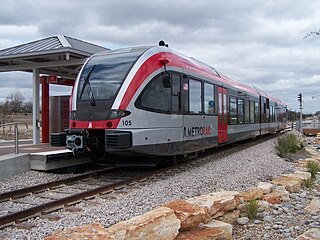
The Stadler GTW is an articulated railcar for local transport made by Stadler Rail of Switzerland. GTW stands for Gelenktriebwagen.
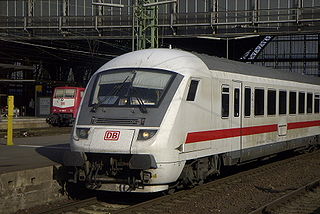
A control car, cab car, control trailer, or driving trailer is a non-powered rail vehicle from which a train can be operated. As dedicated vehicles or regular passenger cars, they have one or two driver compartments with all the controls and gauges required to remotely operate the locomotive, including exterior locomotive equipment such as horns, bells, ploughs, and lights. They also have communications and safety systems such as GSM-R or European Train Control System (ETCS). Control cars enable push-pull operation when located on the end of a train opposite its locomotive by allowing the train to reverse direction at a terminus without moving the locomotive or turning the train around.

The Rhine-Main S-Bahn system is an integrated rapid transit and commuter train system for the Frankfurt/Rhine-Main region, which includes the cities Frankfurt am Main, Wiesbaden, Mainz, Offenbach am Main, Hanau and Darmstadt. The network comprises nine S-Bahn lines, eight of which currently travel through the cornerstone of the system, a tunnel through central Frankfurt. The first section of this tunnel was opened on May 28, 1978. Further tunnel sections were opened in 1983 and 1990, before its completion in 1992. The system belongs to the Rhein-Main-Verkehrsverbund (RMV) and is operated by DB Regio, a subsidiary of Deutsche Bahn.
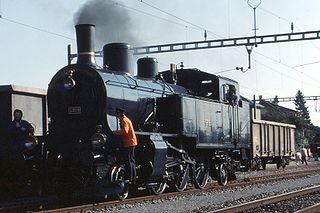
For more than a century, the Swiss locomotive, multiple unit, motor coach and railcar classification system, in either its original or updated forms, has been used to name and classify the rolling stock operated on the railways of Switzerland. It started out as a uniform system for the classification and naming of all rolling stock, powered and unpowered, but had been replaced and amended by the UIC classification of goods wagons.
The Stadler Regio-Shuttle RS1 is the first widely used, new-generation, diesel railcar in Germany and Czech Republic for local railway services. Its most characteristic feature is the trapezium-shaped window frames. The Regio-Shuttle is classified by the Deutsche Bahn as Class 650, by the České Dráhy as Class 840 or Class 841, however numerous private railways have their own Regio-Shuttles.
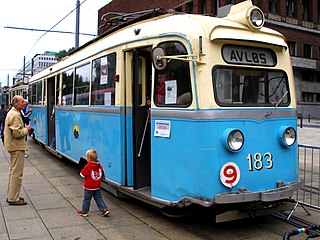
Class B and Class E, normally referred to as Gullfisk, were a class of 46 trams built by Strømmens Værksted and Skabo Jernbanevognfabrikk for Oslo Sporveier and Bærumsbanen of Oslo, Norway, in 1937 and 1939. They were the first aluminium trams to operate on the Oslo Tramway and the first bogie trams to operate on street lines. They had contemporary modern electronic equipment, a streamlined shape, and comfortable accommodation. Until 1964, they were also faster than any other Norwegian tramcar or suburban railcar.

The Rhaetian Railway Be 4/4 is a class of 11 kV 16.7 Hz AC metre gauge railcars operating under the traffic numbers 511–516 on the so-called core network of the Rhaetian Railway (RhB), which is the main railway network in the Canton of Graubünden, Switzerland.

The former ČSD Class EMU 29.0, now known as the ZSSK Class 405.95, is a three member class of metre gauge, rack rail, electric multiple unit trains in service on the Štrbské Pleso – Štrba rack railway, in the Prešov Region of northeastern Slovakia.

The former ČSD Class EMU 89.0, later known as the ŽSR Class 420.95, was a class of metre gauge electric multiple units operated from the late 1960s until 2001-2002, on the Tatra Electric Railway (TEŽ), in the Prešov Region of northeastern Slovakia.

The Class 430 EMU is an electric railcar for S-Bahn commuter networks in Germany, jointly developed by Bombardier and Alstom. The first trains went into service in 2012, replacing the Class 420 EMUs of the Stuttgart S-Bahn.
The Upper Rhine Railway Company, was a railway infrastructure company and transport company based in Mannheim, Germany. It operated the metre-gauge railways among Mannheim, Heidelberg and Weinheim. The company was merged with MVV Verkehr AG on 16 March 2010.
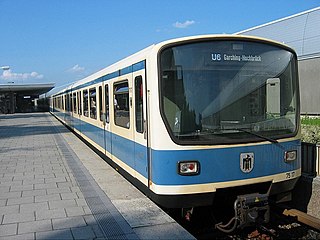
The MVG Class B is an electric multiple unit (EMU) train type operated by the Münchner Verkehrsgesellschaft on the Munich U-Bahn system. The prototypes were delivered in 1981, and the full-production units from 1987. A derivative of the Class B, the VAG Class DT2, is in service on the Nuremberg U-Bahn system.

The MVG Class A is an electric multiple unit (EMU) train type operated by the Münchner Verkehrsgesellschaft on the Munich U-Bahn system. It is the first and oldest type of rolling stock in service on the Munich U-Bahn, and is used on all lines. The prototypes were delivered in 1967, and the full-production units from 1970 until 1983. A derivative of the Class A, the VAG Class DT1, is in service on the Nuremberg U-Bahn system.

The BVG Class C was a series of Grossprofil cars used on the Berlin U-Bahn after 1926. In comparison to the previously built Class B, these 18 meter long cars were about five meters longer than their predecessors. They were therefore classified as Langwagen.

The VAG Class DT1 is an electric multiple unit (EMU) train type operated by the Verkehrs-Aktiengesellschaft Nürnberg on the Nuremberg U-Bahn system since its opening in 1972. It is a derivative of the MVG Class A, in service on the Munich U-Bahn since 1971.




















